Repairing a Tektronix 465 (power supply, z axis amplifier, vertical pre amplifier issues)

Here are some pics of my new Tektronix 465 and how I had repaired it. It was bought on ebay and did not work. There have been several issues to solve, but finally I got a working 465. I found problems in these units:
- power supply
- z axis amplifier
- vertical pre amplifier (channel 2)
- Broken kobs
- Volts/DIV Lamps/Bulbs are broken/do not work
About Tektronix 465

The 465 is a legendary product from Tektronix. Tektronix is said to be the company who invented the oscilloscope (in 1946, with model 511). As you can see in the image, they had a oscilloscope beam tube and a scope sinus signal display as part of their trademark.
As far as I know, the 465 came to the market in the early 1970-ties. It was a general-purpose analogue scope with a (for that time) large bandwidth of 100Mhz and two time bases for a price at that time of ~3500$. Tektronix sold the 465 very well and it is also said to be the most frequent scope in the world.
There are different models starting with 46?:
- 465: The original one, 100Mhz bandwidth. Implemented mostly using transistors, only a few ICs are used in the design.
- 465B: A version that came up some years later, specs were the same as for the 465, but the technology used inside the scope was newer. It uses e.g. ICs in the pre amps.
- 465M: version with a digital multimeter (named DM44) mounted on top.
- 468: A scope with digital storage, based on the 465B design. The digital scope part is based heavily on IC-technology. It has only 25Ms/s.
- (also 475 with 200Mhz bandwidth, 475A with 250Mhz bandwidth, 485 with 350Mhz bandwidth, …)
Because the 465 uses only very few integrated circuits, it can be repaired relatively easy. It is said that the 465 was the last of the tektronix devices based (nearly) completely on discrete components. There is a big load of documentation in the internet including service manual and complete schematics. In many cases it is possible to replace tektronix parts (for example tektronix transistors) with todays standard transistors if the original ones break.
Devices that use many ICs, often sold only by tektronix itself, can be repaired only if you know from where to get replacements for the ICs if they are broken. Today’s scopes are of course all built using heavily ICs.
State how I received it
These are some pictures of the state of the device as I received it from ebay seller. My Tek 465 was manufactured in Netherlands. PCBs are stamped with year 1971, but I believe its newer (serial number is 710090).
Hint: you can click on all images below to enlarge them!

 Frontplate Check: Volts/Div Knob at Channel 2 is
broken. Someone replaced it with an own solution. The red “VAR”-part is still
there and the scale is also there. A Trigger Level Knob is also broken, but
still there and usable. If there were lights at Volts/Div Knobs, they do not
work anymore. Device came dirty.
Frontplate Check: Volts/Div Knob at Channel 2 is
broken. Someone replaced it with an own solution. The red “VAR”-part is still
there and the scale is also there. A Trigger Level Knob is also broken, but
still there and usable. If there were lights at Volts/Div Knobs, they do not
work anymore. Device came dirty.
 Switched it on and hooked on some sinus signal at
Channel 1. In the back, my Tek 2432 shows how the signal really looks like. The
Tek 465 does display something, but very different from actual waveform.
Switched it on and hooked on some sinus signal at
Channel 1. In the back, my Tek 2432 shows how the signal really looks like. The
Tek 465 does display something, but very different from actual waveform.
 That’s left from CH2 Volts/Div Knob.
That’s left from CH2 Volts/Div Knob.
Internals
At first some some random pictures from the inside of the Tek 465.
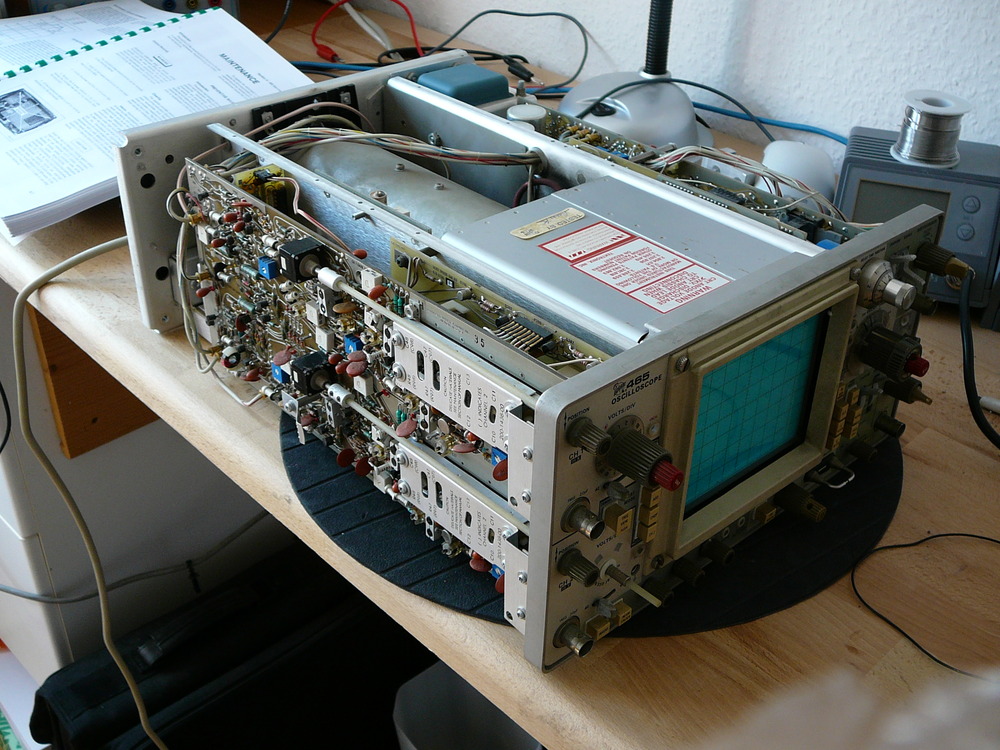

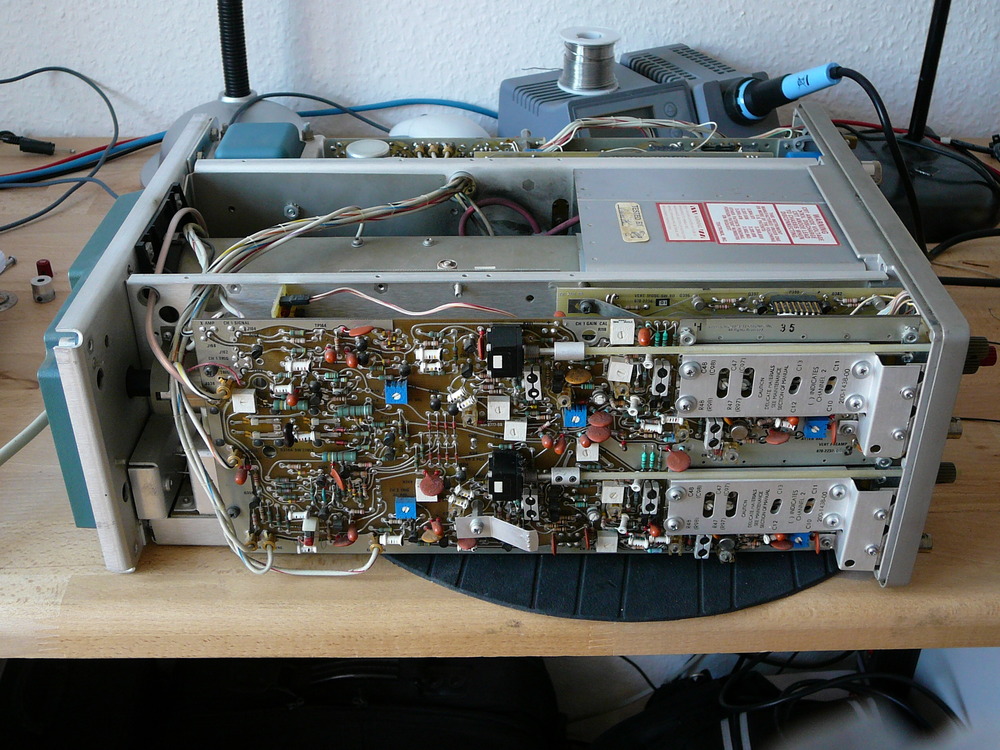
 Delay Line can be seen below the display tube.
Delay Line can be seen below the display tube.




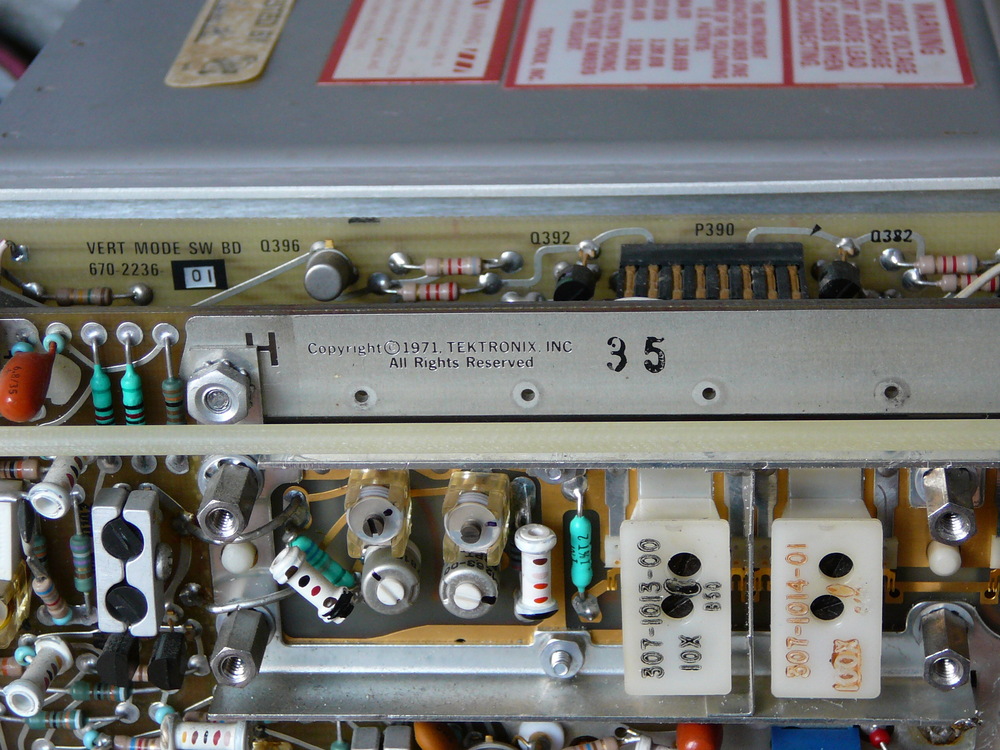 Channel 1 Input Attentuators
Channel 1 Input Attentuators




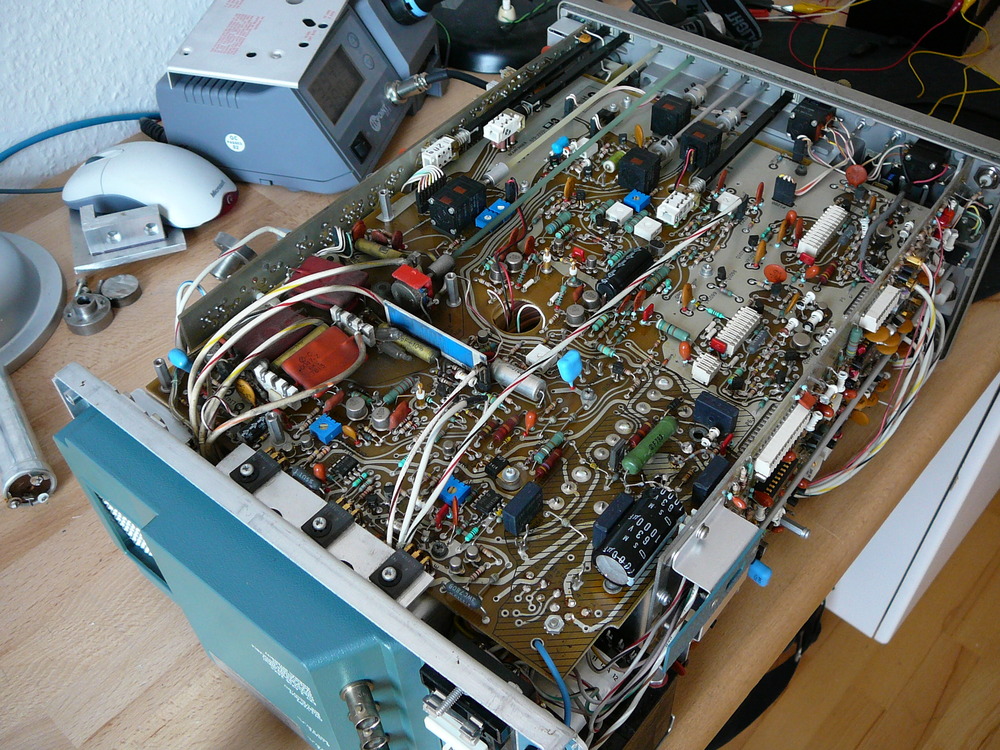 Interface Board (Bottom of device; HV cover
removed.The big black cap at the lower right is not original and located there
for testing)
Interface Board (Bottom of device; HV cover
removed.The big black cap at the lower right is not original and located there
for testing)
 With the scope came this probe. It’s a P6006 (10x,
35Mhz) Probe, equipped with a banana tip. More Info in this Probe can be
found here.
With the scope came this probe. It’s a P6006 (10x,
35Mhz) Probe, equipped with a banana tip. More Info in this Probe can be
found here.
Trying to repair it
At first I fixed one small problem at input of channel 1. A resistor-pin was detached from its target. This did not improve the overall result.
After opening the case and pressing around at PCBs and components, I got sometimes an improved display (see below). But it was not stable in any way. I noticed that hitting the big cap (5500µF) at the +15V voltage leads to big changes in display.
So I decided to change this cap. Infos about the 465 show that these caps are often failing after 30 oder 40 years…
 I got this after pressing around at the PCBs and
hitting on the big poser supply cups…
I got this after pressing around at the PCBs and
hitting on the big poser supply cups…
 Channel 1 Input. One Resistor pin is detached from
input line. I solder it to the input line.
Channel 1 Input. One Resistor pin is detached from
input line. I solder it to the input line.
After Cap replacement, I switched on the device. Immediately, the fuse F1419 broke. I replaced the fuse with an Ampere meter and measured a large current ( 10,5 Ampere). Despite switching the device on for only some seconds, the main fuse broke. Something smelled bad because it was getting hot, but I could not find that thing.
My conclusion from that was: When replacing the cap, some solder fell into the Tek 465 and created a shortcut on the interface board. I did not notice that and when switching the device on, the fuses broke (this conclusion was wrong, because another cap had a shortcut, I found out this later…see below).
I removed the interface board and cleaned the backside because I thought there is solder that produces shortcuts. I re-inserted the interface PCB afterwards.
Without F1419 the device could be switched on. I checked the power supply. I found several issues here:
- Q1556 (5V regulating transistor) was broken
- U1554 (Op-Amp for 55V regulation) was broken.
I replaced both parts.
 Q1556 (a MSPS3414) was broken (no connectivity
between the three pins). I replaced it with a BD677.
Q1556 (a MSPS3414) was broken (no connectivity
between the three pins). I replaced it with a BD677.
 U1554 was also broken. I replaced it with a LF353 (
it will be replaced with a NE5532 as soon as I have one)
U1554 was also broken. I replaced it with a LF353 (
it will be replaced with a NE5532 as soon as I have one)
After this, I could insert F1419 without shortcut and got back some beam traces like at the start of my repair try.
But suddenly there was the shortcut again. Now I saw whats happening, because the HV-shield was removed. A Cap (47µF, C1419) went very hot and even some smoke came out of it. I took it out and measured a resistance of about 50 Ohms. No capacity. I replaced the cap and for the first time, the power voltages look good, except the +15V.
I also noticed that the fan board was using to much load and removed it from 15V supply. 15V now got better, but was not totally stable and still ~1V below it’s should-be value.
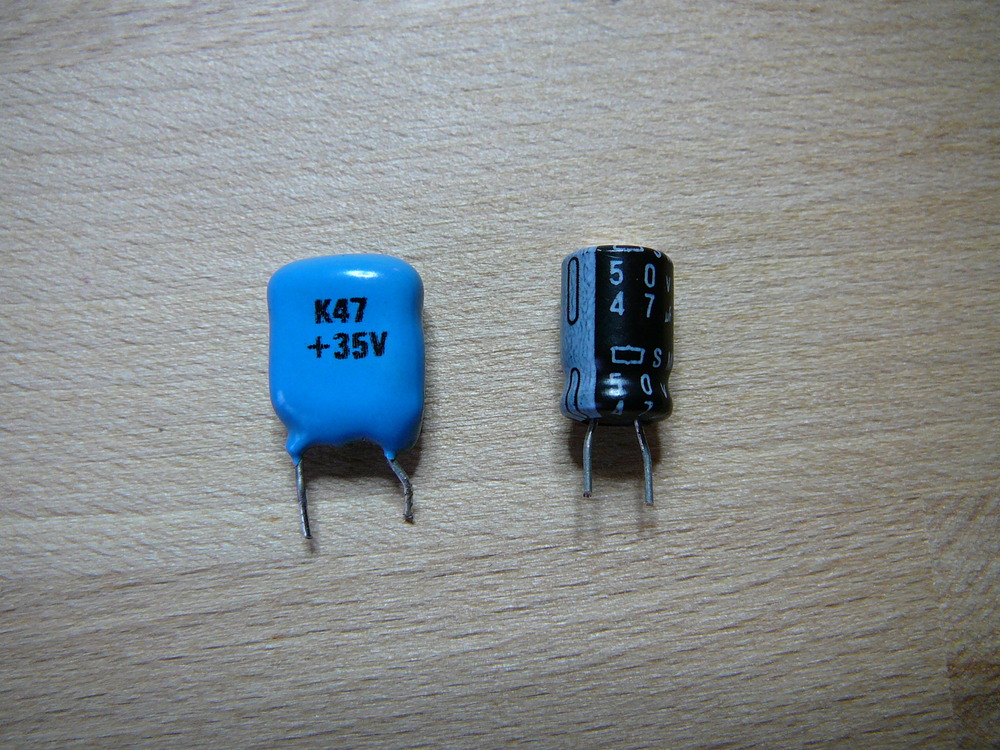 Bad Cap C1419 (left) and its replacement (right).
The bad cap still looks nice!
Bad Cap C1419 (left) and its replacement (right).
The bad cap still looks nice!
The beam traces were still not good.
 A sinus signal, very blurred and distorted at the
right side
A sinus signal, very blurred and distorted at the
right side
 A rectangle signal, looking very bad.
A rectangle signal, looking very bad.
I checked the vertical preamps for both channels. At channel 1, the signals are close to these mentioned in the service manual. At channel 2, a large ripple voltage (100Hz) is added to the test signal.
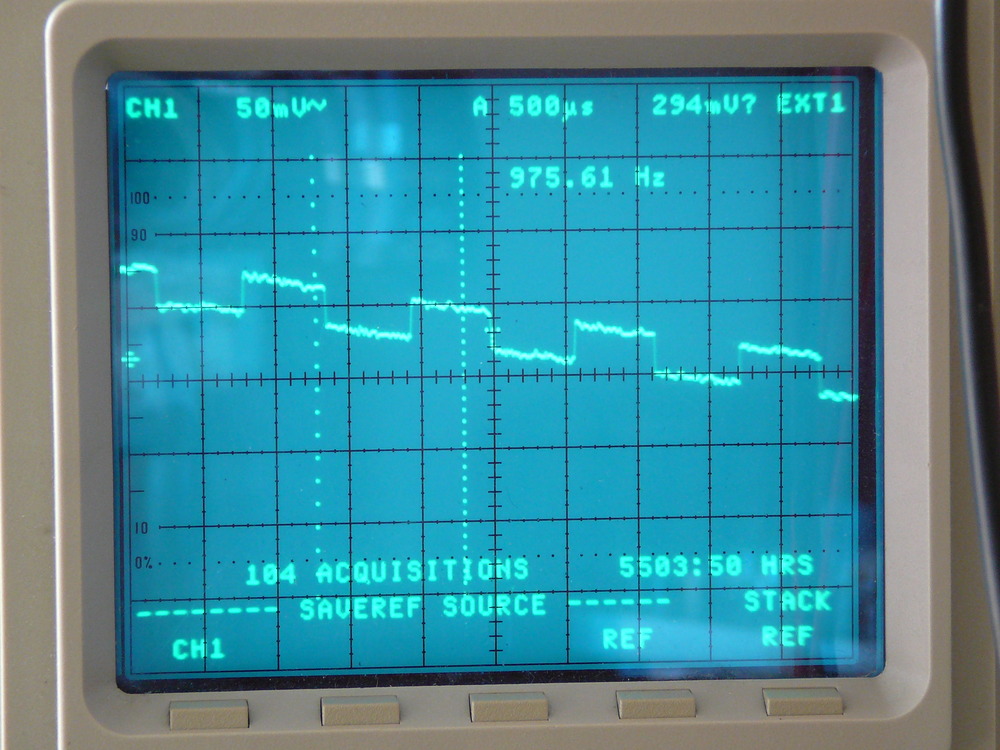 This image shows the test signal (~975Hz). To the
test signal, another low frequency signal (ripple voltage) is added, resulting
in the diagonal baseline.
This image shows the test signal (~975Hz). To the
test signal, another low frequency signal (ripple voltage) is added, resulting
in the diagonal baseline.
 Here the ripple signal can be seen, it has 100Hz.
The ripple amplitude is much larger then the test signal.
Here the ripple signal can be seen, it has 100Hz.
The ripple amplitude is much larger then the test signal.
 The ripple comes from +15V supply. I checked the
other power supplys, they have a very small ripple of some mV. The +15V supply
has 990mV ripple, which is more than 6% of 15V.I wonder why the ripple is a
triangle waveform (I expected sinus)
The ripple comes from +15V supply. I checked the
other power supplys, they have a very small ripple of some mV. The +15V supply
has 990mV ripple, which is more than 6% of 15V.I wonder why the ripple is a
triangle waveform (I expected sinus)
The signal displayed at Tek465 seems to be related to the ripple, compare the next two images:
 This is what 465 displays on channel 2. Input signal
is a rectangle signal.The rectangle signal result in two dashed parallel lines.
Without rectangle signal, there is only one line and no dashes.The ripple is
added to the rectangle signal. Because the ripple is so large, the resulting
signal crosses the whole screen.
This is what 465 displays on channel 2. Input signal
is a rectangle signal.The rectangle signal result in two dashed parallel lines.
Without rectangle signal, there is only one line and no dashes.The ripple is
added to the rectangle signal. Because the ripple is so large, the resulting
signal crosses the whole screen.
 This is the signal measured in the path of channel
2. The big ripple signal can be seen (~170mV). On top of it the test signal (
very small, maybe 5mV) is added. (The smaller ripple curves in the middle seem
not to carry the test signal)
This is the signal measured in the path of channel
2. The big ripple signal can be seen (~170mV). On top of it the test signal (
very small, maybe 5mV) is added. (The smaller ripple curves in the middle seem
not to carry the test signal)
The following pictures show that the signal is very blurry.
 This is the test signal. Sinus, 1000Hz and 500mV
amplitude.
This is the test signal. Sinus, 1000Hz and 500mV
amplitude.
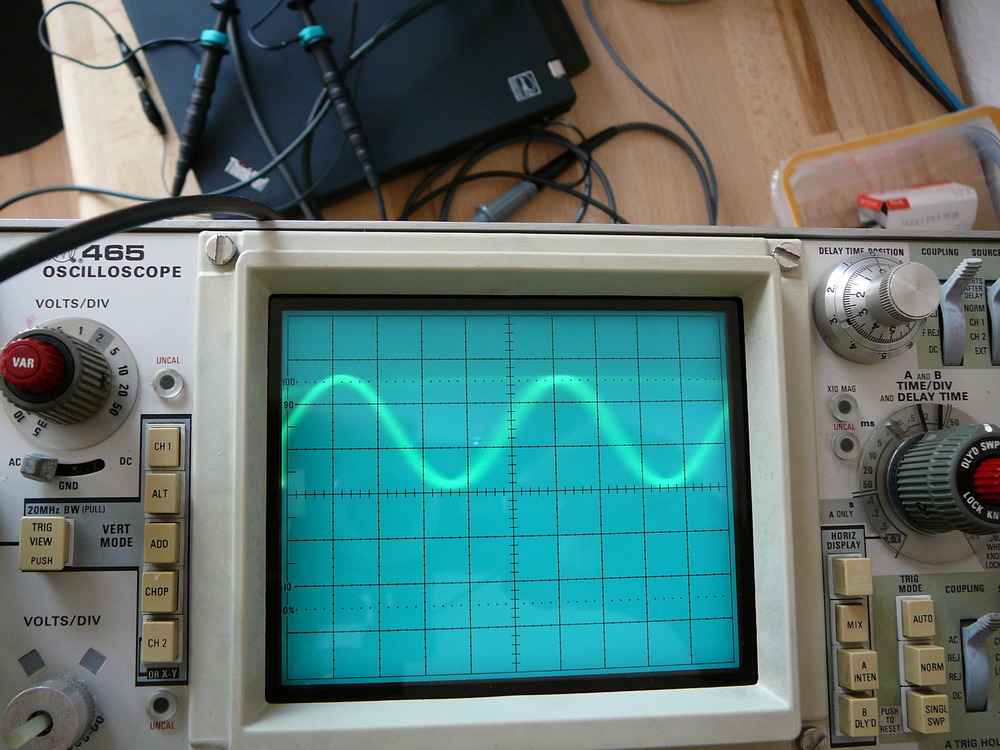 Tek465: channel 1: signal blurred, but amplitude and
frequency and look ok.
Tek465: channel 1: signal blurred, but amplitude and
frequency and look ok.
 Tek465: channel 2: signal blurred,
amplitude/frequency ok. Signal display is very unstable, see next image…
Tek465: channel 2: signal blurred,
amplitude/frequency ok. Signal display is very unstable, see next image…
 Tek465: channel 2: signal display jumps frequently
to something like this
Tek465: channel 2: signal display jumps frequently
to something like this
 Tek 465: displaying both channels with CHOP mode.
Blurred. Because the intensity knob does not work, I can not make it brighter
than this.
Tek 465: displaying both channels with CHOP mode.
Blurred. Because the intensity knob does not work, I can not make it brighter
than this.
After testing around and by Help of people from the Tek Group at Yahoo Groups, I understood that something is still wrong with the +15V power supply.
I checked the driver transistor (Q1544) and the foldover detection transistor ( Q1548) and found both defect. These are 2N2222, I replaced them with BC547B which I had in my component boxes and for the first time I got really 15V ( 14,998). And the interesting thing, the ripple voltage completely disappeared.
 Replacement of Q1544/Q1548
Replacement of Q1544/Q1548
Meanwhile I had also replaced C1220 (a large cap which went warm, it still worked but to be sure I replaced it).
I could also replace the “Interim”-Op-Amp LF353 (which replaced a MC1548) with a NE5532. The other MC1548 (which is ok) was also replaced by the technically improved NE5532.
I also checked the display illuminance section and found both lamps defective and also the driving transistor MSPS3414. I replaced lamps and transistor (BD677 as a replacement). Now illuminance is ok again. (to be honest, I tried first to replace the lamps with 3 LEDs and a 470 ohms resistor. But the result was not bright enough and I replaced that again with real lamps).
 Display illuminace lamps are hidden in this white
box.
Display illuminace lamps are hidden in this white
box.
This was the first time I tried to improve the look of the signals which looked very blurred. I was able to make signals look much better. Both channels seem to be display the waveforms fully correct now.
Fixing the Z axis amplifier
At this state the following issues were left:
- Intensity knob has no effect
- Beam return is not hidden (I can see the beam returning)
- Volts/Div Knob at Channel 2 is broken.
- “A Trigger Level” Knob is broken
- Volts/DIV Lamps/Bulbs are broken/do not work
1. and 2. were related to the Z Axis section of the device, so they seem to be related.
The beam return signal is not suppressed and can be seen on the screen. See the two following pictures.
 Displaying rectangle waveforms, looking good on both
channels.
Displaying rectangle waveforms, looking good on both
channels.
The visible beam return can be seen on the following image:
 Sinus waveforms look good on both channels. Here the
visible beam return can be seen. Its the dashed line starting at the right end
of the screen and going to the left start of the screen (in fact, left start is
outside of the visible area of the screen). Something is wrong with beam return.
Sinus waveforms look good on both channels. Here the
visible beam return can be seen. Its the dashed line starting at the right end
of the screen and going to the left start of the screen (in fact, left start is
outside of the visible area of the screen). Something is wrong with beam return.
After searching for the problem for some days I identified a shortcut between the collector and the emitter of a transistor in the z axis amplifier (at Q1472) as the source of the problem.
 PCB, z axis amplifier section, Q1472 is removed, the
pin holes can be seen. On this side of the PCB, there is no shortcut. It must be
on the backside…
PCB, z axis amplifier section, Q1472 is removed, the
pin holes can be seen. On this side of the PCB, there is no shortcut. It must be
on the backside…
To remove the shortcut, the interface board has to be removed again.
Just to probe my suspection, I isolated the shortcut by removing all components from the PCB that were connected with Emitter of the transistor and wired everything together with some wires. For the first time, I could vary intensity and the beam return signals were not visible anymore. Z axis amp worked again!
 Sticking all components desoldered from the PCB
together in the air using some wires for a test
Sticking all components desoldered from the PCB
together in the air using some wires for a test
 Intensity knob works again and the beam return is
suppressed on the display as it should be! My 465 works!
Intensity knob works again and the beam return is
suppressed on the display as it should be! My 465 works!
After this, I tried to calibrate the scope. Calibration is described extensively in the service manual.
During calibration, I noticed that I could not calibrate the channel 2 amplitude. For 300mV in the 100mV-Range, I only get 2 graticules amplitude on the display, correct would have been 3 graticules. So there was another error, obviously in the channel 2 vertical pre amplifier.
I started exchanging transistors between both channels with no result. All were good. The problem seems to be in a passive component around the second amplifier stage.
 Transistors, even pairs of them, can be exchanged
easily on the old teks, because they are not soldered but stick on the PCBs
Transistors, even pairs of them, can be exchanged
easily on the old teks, because they are not soldered but stick on the PCBs
 Close to the solution: The interesting thing is the
150 ohms resistor in the middle of the picture. It looks optically well. On its
left pin I have a signal that I do not have on the same resistor pin at the
other channel. Measurement at this resistor pins reveals a value of ~12KOhms.
There is something wrong with that resistor. I decided to desolder it for
further checks.
Close to the solution: The interesting thing is the
150 ohms resistor in the middle of the picture. It looks optically well. On its
left pin I have a signal that I do not have on the same resistor pin at the
other channel. Measurement at this resistor pins reveals a value of ~12KOhms.
There is something wrong with that resistor. I decided to desolder it for
further checks.
 When touching the resistor during desoldering, I
found that it was broken in two parts that stayed close together, looking as if
its still ok, but without electric function anymore!
When touching the resistor during desoldering, I
found that it was broken in two parts that stayed close together, looking as if
its still ok, but without electric function anymore!
 After repair, nice looking signals on both channels.
Unit was also cleaned :-)
After repair, nice looking signals on both channels.
Unit was also cleaned :-)
 And these are all parts I replaced: The big cap from
the power supply, another cap that went warm for no reason (black one), the
op-amp from the power supply, the cap C1419 with an internal shortcut (blue one)
, two small transistors and a bigger one from power supply, and a bigger
transistor from the screen illumination section, from there also two light
bulbs. At the bottom the broken resistor from the vertical pre amp.
And these are all parts I replaced: The big cap from
the power supply, another cap that went warm for no reason (black one), the
op-amp from the power supply, the cap C1419 with an internal shortcut (blue one)
, two small transistors and a bigger one from power supply, and a bigger
transistor from the screen illumination section, from there also two light
bulbs. At the bottom the broken resistor from the vertical pre amp.
Replacement of Volt/DIV - lamps/bulbs
The Tek 465 autodetects 1x and 10x probes (if they provide a readout for that). For those different probes, two light bulbs behind the transparent Volts/DIV-Knob shows the valid settings on both channels. At my scope, all four lamps were broken.
To replace the lamps, the complete vertical pre amp has to be detached from the scope. The removal is well described in the service manual, but it lasts some time. I replaced the lamps with LEDs, because LEDs last much longer than ordinary bulbs.
Hint: I was informed by one of the readers of this document that simply replacing the bulbs with LEDs did not work in all cases. My Tek 465 is a newer one that can handle without changes the different (i.e. reduced) load from LEDs. Older Tek 465 devices (below S/N B250000) will not work as expected. It is possible to modify the scheme from the old version to the new version by adding one resistor (R392/47K) and by removing another one (that connects base of Q392 and Collector of Q396). I haven’t tested this.
 The detached vertical preamp. On the left, the two
light bulb cabins made of white plastics can be seen
The detached vertical preamp. On the left, the two
light bulb cabins made of white plastics can be seen
Each LED gets a 220 ohms resistor, so I have a LED current of about 15mA.
 After removing the old bulbs I soldered LED+resistor
together, adjusted the pins as good as possible and inserted the new lights into
the white cabins. There is very few space to solder. The polarity of the LEDs
has to be taken into account. + is always at the outer left and right end of the
cabin, the two pins that are already soldered together are the - pin for the
LEDs.
After removing the old bulbs I soldered LED+resistor
together, adjusted the pins as good as possible and inserted the new lights into
the white cabins. There is very few space to solder. The polarity of the LEDs
has to be taken into account. + is always at the outer left and right end of the
cabin, the two pins that are already soldered together are the - pin for the
LEDs.
After putting everything together, I noted that the 465 always thinks that it has a 10x probe in channel 2. A quick test shows that the driver transistor Q392 was defect. I replaced it with a BC550B and everything is fine now.
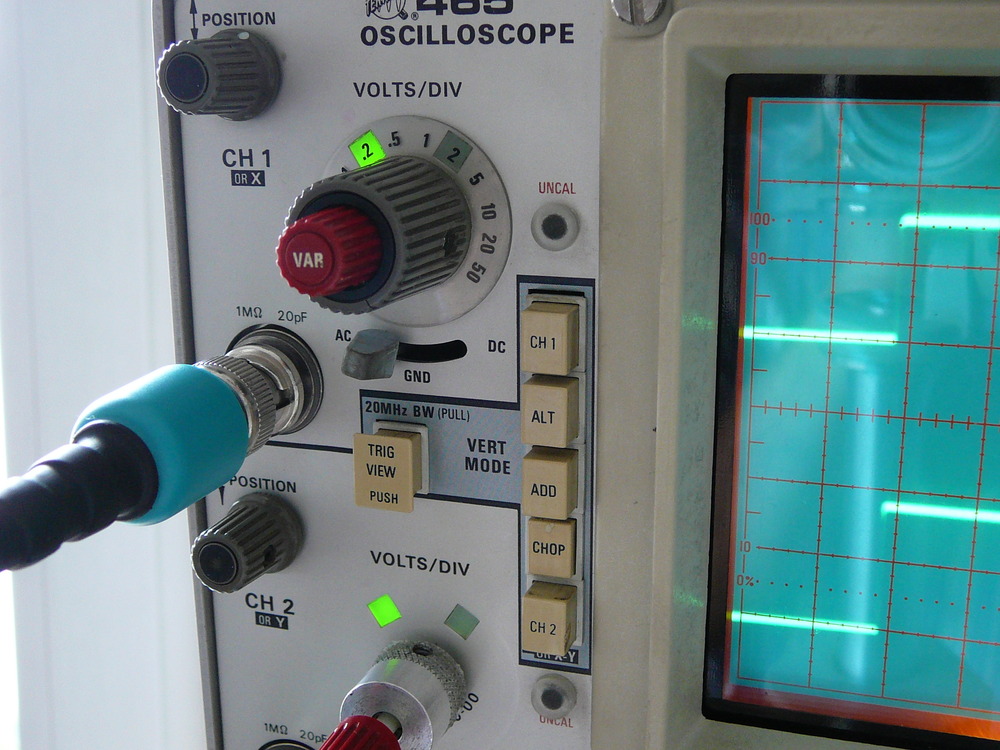 These are the lights after putting everything
together again. (Note that the channel 2 knob is not yet replaced with a new
one.) I like the green lights!
These are the lights after putting everything
together again. (Note that the channel 2 knob is not yet replaced with a new
one.) I like the green lights!
After all, I have now a nice second scope on my work bench!
I was also able to buy a completely broken 465 in ebay for less than 20 Euro and could combine the best knobs and switches from both devices, so I have no broken front knobs anymore. The completely broken 465 came in parts and as far as I could see, it was complete except the CRT tube. So I keep the parts, maybe I can get some cheap CRT someday. The 465 CRT with Tek Part No. 154-0676-10 comes from Tektroniks itself. I read from internet sources that also the tek CRTs 154-0731-00 (for 465B) and 154-0861-00 (e.g. for Tek 2235) can be used as an replacement (no guarantee for this).
Links
Tektronix Forum at Tektronix Tektronix Parts Shop
bluefeathertech.com - Site with Docs for many old measure devices amplifier.cd - (german) hints for repairing old tektronix devices (hints are for 7000 mainframe series, but usable anywhere) Barrytech - Site with many infos and photos from Tektronix devices Tek Gallery ( amplifier.cd) - (german) Nice gallery of many tektronix devices Reprise Tek Site
- Many infos on Tek devices by two tek employees Helmut Singer Elektronik - (besides other trademarks) used tek devices in germany
